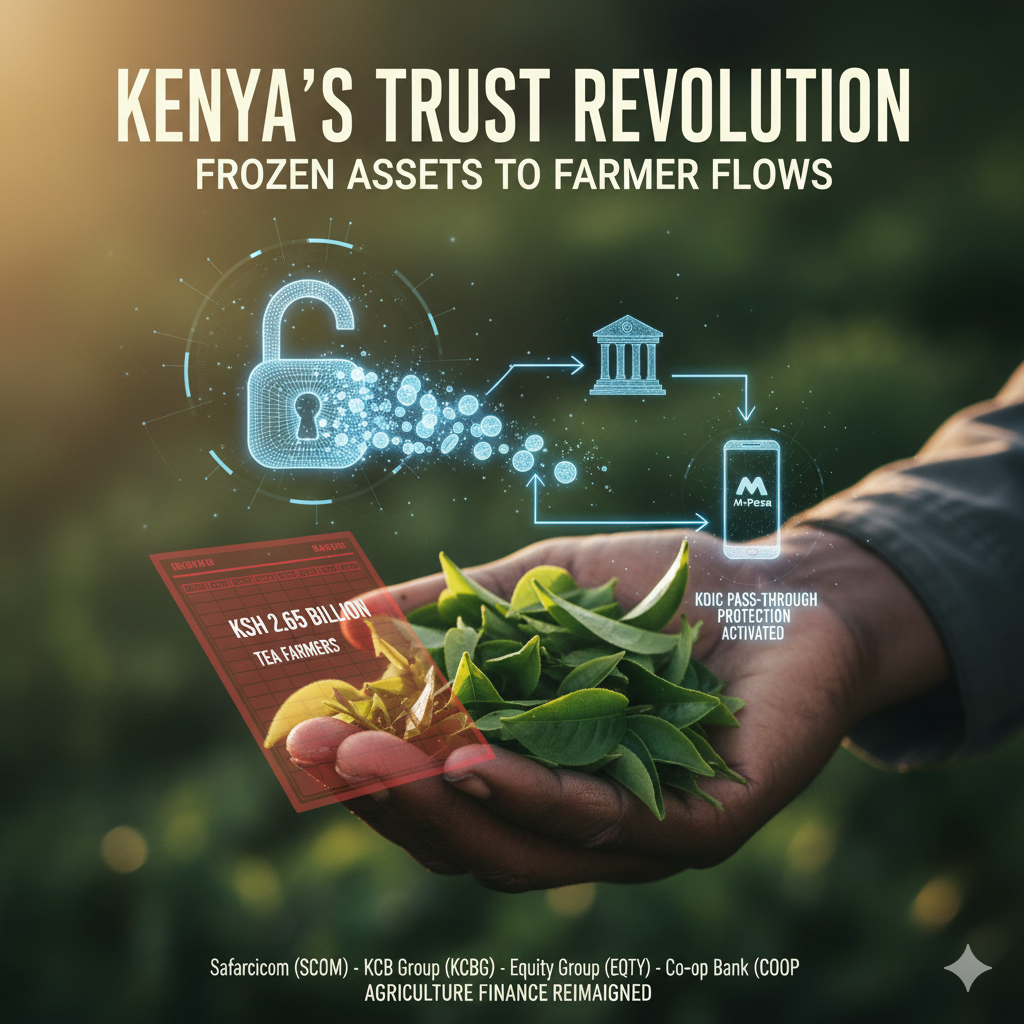From Frozen to Flowing: Kenya’s KSh2.65bn Tea Cash Unlock
Kenya unlocked KSh2.65bn for 600k–680k tea farmers by activating KDIC pass-through protection on trust accounts. The cash jolt lifts rural wallets and trims “resolution friction” in agri-finance—mildly bullish for payments and deposits while tightening risk pricing.

Kenya has turned legal clarity into cashflow. Under new KDIC trust-account rules, roughly KSh 2.65 billion trapped in failed banks has been released to tea farmers via KTDA. Practically, well-documented trust/escrow balances now receive “pass-through” protection: insurance attaches to named beneficiaries instead of the trustee. That converts previously frozen claims into immediately payable balances without violating creditor hierarchies.
Scale and velocity matter for markets. KTDA represents about 600k–680k smallholders; a KSh 2.65 billion injection implies an average KSh 3,900–4,400 per farmer if spread evenly, with distributions likely lumpy across factories. Expect a short-run lift in rural cash cycles and digital payments. This is mildly supportive for Safaricom (NSE: SCOM) via M-Pesa transaction volumes and float, and for tier-1 deposit growth at KCB Group (NSE: KCBG), Equity Group (NSE: EQTY) and Co-operative Bank (NSE: COOP), which dominate agri counties.
The structural win is risk compression. Kenya’s general deposit-insurance cap remains KSh 500,000 per depositor per bank. The difference now is explicit pass-through eligibility for properly segregated, ledger-clean trust accounts—crucial for producer organisations that routinely hold auction proceeds, levies and payroll floats for thousands of beneficiaries. Over time, this reduces the “resolution friction” premium lenders price into agri working-capital lines. Expect marginally better tenors and a few basis points of pricing benefit for compliant cooperatives and factories as banks internalize lower loss-given-failure on funds-in-trust.
Regional context sharpens the point. Tanzania’s DIB covers up to TZS 7.5 million (≈KSh 420k), Uganda’s DPF up to UGX 10 million (≈KSh 350k), South Africa’s new CODI up to R100,000, and Nigeria’s NDIC up to ₦5 million. Kenya’s headline cap isn’t the outlier; the innovation is the operationalized pass-through for mass-beneficiary trust structures—exactly the use-case in East African agriculture.
This is not stimulus; it’s the release of existing balances to rightful owners. Impact durability will be governed by documentation, not politics. Trust protection is conditional: co-mingled funds, incomplete beneficiary lists or non-designated accounts fall back to the KSh 500,000 cap, limiting recovery and re-introducing litigation risk. Producer organisations must maintain beneficiary-level ledgers, reconciliation trails and bank segregation to keep protection live.
What to watch next is straightforward. First, disbursement cadence and channel (bank vs mobile wallets) to gauge the near-term consumption impulse. Second, replication: coffee, dairy and horticulture funds using compliant trust set-ups should be able to unlock stranded balances on the same logic—broadening the macro footprint. Third, bank disclosures: look for changes in internal policies on client trust accounts and any commentary on fee income or deposit mix in agri regions. Fourth, KTDA bonus circulars to see how much of the KSh 2.65 billion passes through to farmer payouts versus factory balance-sheet repairs.
For investors this should be treated as a two-track positive. Near term, a modest bump to payments volumes (SCOM) and agri-region deposits (KCBG, EQTY, COOP). Medium term, quieter but more valuable—lower operational risk across agri value chains, slightly cheaper working-capital funding for compliant producer bodies, and a more credible safety-net architecture that should dampen resolution-cycle uncertainty premia.





